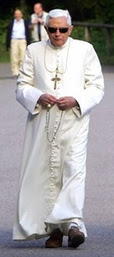One of my housemates has been reading a book about early Catholic Australia. Readers outside of Oz may not know that, despite the initial Catholic portion of the settlers being nearly all Irish, and mostly convicts, the first bishops and many priests sent to minister to them were not Irish - but English Benedictines.
Unfortunately, but perhaps all too understandably, the grand dream of turning Catholic Australia into a monastic stronghold faded - there were never enough vocations either from England or among the Australian settlers to sustain the Benedictine vision, and in the end, even St Mary's Cathedral in Sydney, which had been for many decades a Benedictine abbey in name if not in fact, was given over to the triumphant Irish secular clergy, to the delight of the new generation of Irish bishops that replaced those first Benedictine prelates, like Polding, Ullathorne (who returned to England), and Vaughan.
Now to the issue at hand: a quotation from the Benedictine Journal of 1845 describes
'the splendour of the ceremonies in St. Mary's' especially of the sung High Mass and Vespers, which... also attracted many Protestants 'if not for prayer at least to look on and admire the magnificence of the sacred ceremonies'.
Of course, back then Anglicans scarcely even sang hymns, making their pre-Oxford Movement Sunday 'liturgy' horribly intolerable and boring compared to the numinous pomp of the Roman Mass.
Consider, contrariwise, what one would find in a Catholic parish to-day: as my mate said, "Probably a B-grade Protestant service" - with bad preaching, bad reading, and awful singing. The Irish have triumphed indeed!
To be fair, however, a Protestant coming to St Mary's in 2008 would still find a fairly grand liturgy, with an excellent choir and quite some liturgical splendour; having served there myself a few years back, I can attest to this.
Also, way back when, a Low Mass would probably have seemed mysterious, but not quite magnificent to a visitor: I must say, it's the High Mass that displays real splendour even to the untutored eye; the sacred mutter of the Low Mass takes a bit of getting used to. And recall also the suspicion with which all things Popish were regarded - as Dix relates in The Shape of the Liturgy (p.145f),
...I remember that my own grandmother, a devout Wesleyan, believed to her dying day that at the Roman Catholic mass the priest let a crab loose upon the altar, which it was his mysterious duty to prevent from crawling sideways into the view of the congregation. (Hence the gestures of the celebrant.) How she became possessed of this notion, or what she supposed eventually happened to the crustacean I never discovered. But she affirmed with the utmost sincerity that she had once with her own eyes actually watched this horrible rite in progress; and there could be no doubt of the deplorable effect that solitary visit to a Roman Catholic church had had on her estimate of Roman Catholics in general, though she was the soul of charity in all things else. To all suggestions that the mass might be intended as some sort of holy communion service she replied with the wise and gentle pity of the fully-informed for the ignorant.
This may explain why to this day in Sydney the local Anglican leaders (of that sort of churchmanship best described as 'lower than a snake's belly', to quote a High Churchman) refuse any and all invitations to attend Mass!









No comments:
Post a Comment